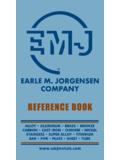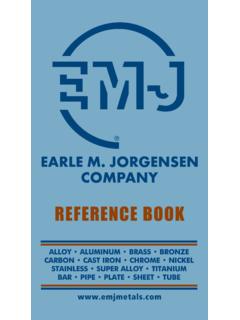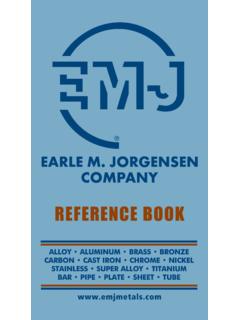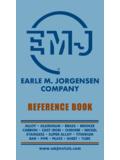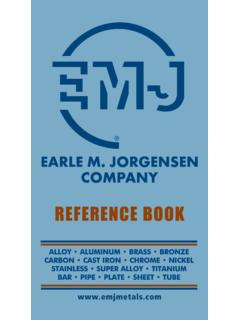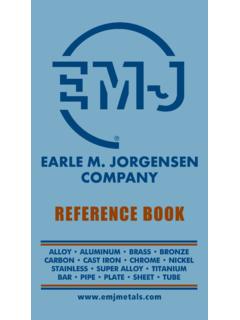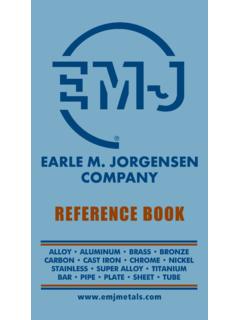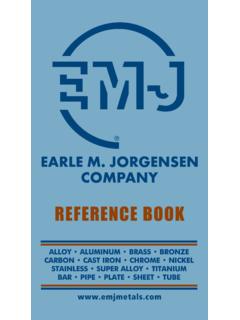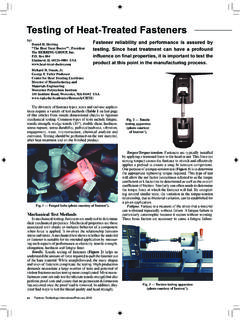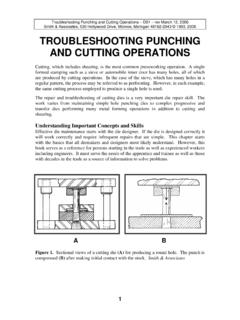Transcription of Section R - emjmetals.com
1 RSection RMecHAnicAL PRoPeRtieS AnD HARDenABiLitYintRoDUction ..2-3cARBon SteeLS carburizing Grades 1018 ..4 1117 ..5 Hardening Grades 1040 ..6-7 1055 ..8-9 1137 ..10-11 ALLoY SteeLS Hardening Grades 4130 ..12-13 4142 ..14-15 4340 ..16-17 6150 ..20-21 carburizing Grades 4620 ..18-19 8620 ..22-23nitRiDinG #3 (135 Modified) ..24 StAinLeSS SteeLS type 410 ..25 type 416 ..26 type 431 ..27 type 440c ..28coRReLAtion Between enD-QUencH HARDenABiLitY teSt AnD RoUnD BARS ..29 Sec . R Page 1 Sec . R Page 2 MecHAnicAL PRoPeRtieS AnD HARDenABiLitYintRoDUction The following pages contain pertinent data on the properties of certain of the more frequently used carbon and alloy steels.
2 Much of the information is based on laboratory tests. However, results of tests of steels of similar composition may differ to some extent due to residual alloy content, agitation of the quenching medium and other variable factors. Therefore, the tables and charts on the following pages are offered only as a guide to (1) those properties that may normally be expected from a particular grade of steel and (2) the treatment to use in order to obtain the desired PRoPeRtieS The mechanical properties (tensile strength, yield point, etc.) shown herein are the results of actual tests performed as follows: carbon Steels . Properties shown are the averages of three heats, selected so that the significant elements are in the middle of the chemical composition limits and incidental elements are at a minimum.
3 Quenched-and-tempered properties are based on treating a 1 round, which is machined down to .505 for the tensile test. All steels tested are fine grain, except the free-machining grades (1117 and 1137), which are coarse grain. Alloy Steels . Properties shown are based on a single heat, selected so that the significant elements are in the middle of the chemical composition limits and incidental elements are at a minimum. Quenched-and-tempered properties are based on treating a .530 round for the hardening grades and a .565 round for the carburizing grades. These sizes are small enough to insure a thoroughly effective quench. Thus, the charts reflect typical values that may be expected of fully-hardened steels.
4 For the tensile test, the pieces are machined down to .505 . All alloy steelstested are fine iMPAct Izod impact values are often difficult to duplicate, and the data shown should be considered only as reasonable expectation. Fine-grain steels normally show higher impact values than coarse-grain steels, and this should be considered when reviewing the Izod RAnGeS Critical ranges are shown for each grade and are based on a heating and cooling rate of 400 per hour. The Ac1 and Ac3 points represent the critical range for heating and the Ar3 and Ar1 points represent the range for effect In order to illustrate the variance in properties occurring among quenched and tempered bars of different sizes, values are shown for 1/2 , 1 , 2 , and 4 rounds.
5 All these values are based on the results of a single heat, which has been selected to represent an average for the grade. Tensile and hardness values are higher on the surface and decrease toward the center. Tensile specimens for 1/2 and 1 rounds are taken from the centers of the bars. Specimens for 2 and 4 rounds are taken from the half-radius position, as is con-ventionally required by most specifications. Sizes larger than 4 round will not show materially lower properties. Sections other than rounds will show approximately the same mass effect relationship as long as the Section width is not more than twice the HARDenABiLitY Since alloy steels are ordinarily used for their deep-hardening characteristics, End-Quench Hardenability (Jominy) charts are given for the alloy grades.
6 These charts show hardenability bands ; that is, the maximum band minimum values that may normally be expected. The broken line within each and represents the harden-ability characteristics of an actual heat, whose mass effect properties are shown under Mass Effect Data. The scale at the bottom of the hardenability charts represents distances from the quenched end of the test specimen. The scale at the top of the charts is for conve-nience in converting the results of the end-quench test to the results that may be expected at the centers of round bars of various diameters when quenched in water or oil. (This correlation between end-quench test results and the centers of round bars is also illustrated in the table on Page 29 of this Section .)
7 In addition, that table gives similar information for the surface and half-radius positions of rounds bars.)Sec . R Page 31018 Analysis critical Range thermal treatmentcarbon .15/.20 Ac1 1360 F forge 2150 - 2250 FManganese .60/.90 Ac3 1530 F normalize 1650 - 1750 FPhosphorus .04 Max. Ar3 1440 F Anneal 1550 - 1650 FSulphur .05 Max Ar1 1300 F MecHAnicAL PRoPeRtieS tensile Yield elongation Red . Area Brinell izod Strength Strength in 2 As Rolled 67,000 45,000 36 58 137 60normalized 66,000 43,000 37 60 137 86 Annealed 60,000 40,000 38 62 121 90 Size Treated, 1 Rd..046 cASe coRe tensile 82,000 Yield 47,000 elongation 27 .0% Reduction 66 .0% Brinell 163 izod 81 R c 62 MASS effect DAtAMock-carburized at 1675 F for 8 hours; reheated to 1425 F; quenched in water; tempered at 350 F.
8 Tensile Yield elongation Red . Area Brinell izod Strength Strength in 2 1/2 Rd. 135,000 67,000 262 Rd. 87,000 55,000 179 Rd. 82,000 50,250 163 Rd. 74,000 40,250 149 Single Quench and temper1. Carburized at 1675 F for 8 Pot Reheated to 1425 Water Tempered at 350 . R Page 41117 Analysis critical Range thermal treatmentcarbon .14/.20 Ac1 1345 F forge 2150 - 2250 FManganese Ac3 1540 F normalize 1650 - 1750 FPhosphorus .040 Max. Ar3 1450 F Anneal 1550 - 1650 FSulphur .08/.13 Ar1 1340 F MecHAnicAL PRoPeRtieS tensile Yield elongation Red . Area Brinell izod Strength Strength in 2 As Rolled 71,000 44,000 33 63 143 60normalized 70,000 42,000 33 63 137 66 Annealed 66,000 41,000 32 58 121 65 Size Treated, 1 Rd.
9 045 cASe coRe tensile 96,500 Yield 59,300 elongation 23 .0% Reduction 52 .7% Brinell 192 izod 33 R c 65 MASS effect DAtAMock-carburized at 1700 F for 8 hours; reheated to 1450 F; quenched in water; tempered at 350 F. tensile Yield elongation Red . Area Brinell izod Strength Strength in 2 1/2 Rd. 124,700 66,500 235 Rd. 89,500 50,500 183 Rd. 78,000 47,750 156 Rd. 77,000 45,000 156 Single Quench and temper1. Carburized at 1700 F for 8 Pot Reheated to 1450 Water Tempered at 350 . R Page 51040 Analysis critical Range thermal treatmentcarbon .37/.44 Ac1 1340 F forge 2100 - 2200 FManganese .60/.90 Ac3 1445 F normalize 1600 - 1750 FPhosphorus.
10 04 Max. Ar3 1350 F Anneal 1450 - 1550 FSulphur .05 Max. Ar1 1250 F Harden 1525 - 1575 F oil or waterMecHAnicAL PRoPeRtieS tensile Yield elongation Red . Area Brinell izod Strength Strength in 2 As Rolled 90,000 59,000 26 50 201 36normalized 87,000 58,000 28 52 192 38 Annealed 80,000 48,000 30 54 159 40 Size treated: 1 Roundnormalized at 1650 fQuenched from 1550 f in waterReduction of Area in Percentelongation in 2 in Percentizod impact in foot/Poundstensile Strength and Yield Strength in Pounds per Square inch250,000200,000150,000100,00050,00010 0908070605040302010400 500 600 700 800 900 1000 1100 1200 1300 tempering temperatureBrinell 514 495 444 401 352 293 569 235 201 187 Rockwell c 51 48 46 42 37 30 27 22 B94 B91tensileYieldReductionizodelongationSe c.

